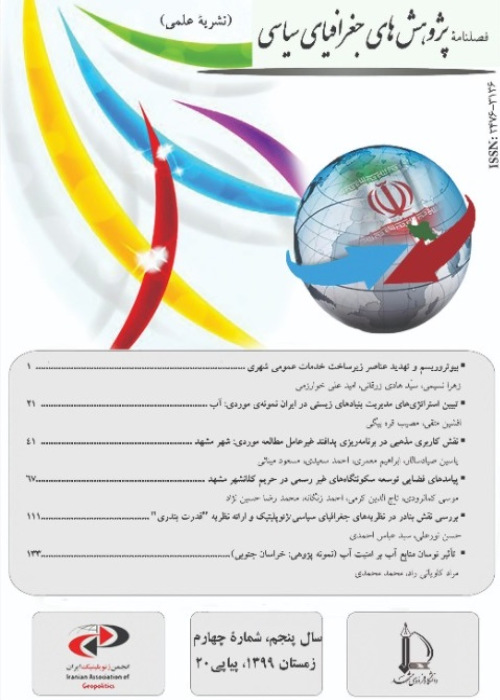The Role of Neighborhood and Religion Variables in the Voting Pattern of the Candidates of the Tenth Parliamentary Election of Iran (Constituency of Qayenat and Zirkouh)
Author(s):
Article Type:
Research/Original Article (دارای رتبه معتبر)
Abstract:
Introduction
Electoral geography discusses "the geographical aspects of elections and referendums, the organization of such events (particularly their results), and the cultural and economic conditions at different local, regional, and national levels" (Moyer, 2000, p. 225). The Elections are one of the main manifestations of democracy in the modern era, and it has become more important than ever with respect to the role of people in determining rulers. Democracy is known as the lawful management of a political society which is executed through the mechanism of transferring the population's will to governance for the administration of countries; thus, elections are indeed considered as the most significant manifestation of democracy. An extensive spectrum of situational and geographical factors influences electoral decisions, and, in general, each study discusses only one aspect of this spectrum. In fact, the outcome of various elections is influenced by spatial and geographical variables at individual and social levels. Additionally, there are factors and actors at local, regional, national, and even international levels which affect the outcome of elections.
Theoretical Framework
The geography of election is one of the branches of political geography focusing on geographical regions as the platform for electing representatives at local, regional, and national levels. The most important electoral geography constituencies are comprised of factors such as "the spatial organization of elections, the spatial diversity of voting patterns, and the relationship with the demographical indexes, the effect of environmental and spatial factors on the voters’ decisions, the spatial patterns of representation, and the role of components such as power and politics in voting patterns" (Kavianirad, 2013, p. 34). In fact, the geography of election focuses on various geographical aspects of elections, and referendums and their organization and results in particular while considering the cultural, economic, and other conditions influential at various local, regional, and national levels. the spatial analysis of election results can offer a specific spatial perspective to determine the approach of each constituency for the candidates, as well as the elections, and also to better identify the factors affecting the voting process (Zarghani & Razavinejad, 2013).
Methodology
The present study is considered as a descriptive-analytical research. Data collection was carried out using library and document studies. The geographic, economic, political, cultural, and social variables are considered to affect the people's vote and the voting pattern of candidates. The neighborhood, as well as the ethnic and religious characteristics, is one of the most important factors affecting the candidates' voting pattern. This study analyzes the role of the three variables of neighborhood, religion and the rural and urban residence on the voting pattern of candidates of the tenth parliamentary election based on authoritative library resources and statistical data in Qayenat and Zirkouh electoral areas.
Results and Discussion
There are various factors and variables involved in people’s decision for voting in favor of one or more candidates from among a number of candidates. In fact, during the process of elections, voting patterns for candidate in elections are a function of components such as the candidates’ characteristics and individual features, as well as political, economic, and sociocultural macro variables and finally the characteristics and personal features of voters. For example, personal characteristics such as age, gender, education, religious beliefs, ethnicity, and spatial attachment might play a role in the person’s decision for voting in favor of a certain candidate. Other effective variables are dependent on the personal characteristics of the candidate, and finally the political, economic, ideological, cultural, and social variables – in both macro and micro scales – can influence citizens’ electoral behaviors.
In fact, variables such as age, gender, degree of education, ethnicity and religion, economic status of voters, and the individual and personality characteristics of the candidates including gender, educational level, power of expression, background and social status, executive and management background, ethnic ties and economic base have a significant influence on the number of people voting for candidates. Finally, more general economic, social and political variables such as governments and other policies and actions of actors, religious leaders and ethnic groups are also influential in this regard.
Conclusion
The results of this study as well as other similar studies on the spatial analysis of parliamentary votes in Iran show that the following factors influence Iranian people’s electoral behavior, ultimately leading to the formation of different voting patterns for the candidates, including ethnicity and ethnic groups’ behavior, religious and ideological variables, the neighborhood variable and the effect of birthplace, the economic variable and the type of economic base, and personal and personality traits of both the voters and the candidates. The research results in the form of tables and maps indicate that the neighborhood variable plays an effective role in the voting pattern of candidates. In addition, the religion factor and Sunni religious minority have also been effective in their voting pattern so that Sunnis are more likely to welcome the reformist candidates similar to presidential elections. Finally, despite the difference in the number of candidates’ votes in urban and rural areas, voters' residency in urban and rural areas has no significant effect on the voting pattern independently, and this variable is influenced by other factors, including the neighborhood, ethnic, regional, and religious variables.Keywords:
Language:
Persian
Published:
Research Political Geography, Volume:2 Issue: 3, 2017
Pages:
105 to 126
magiran.com/p1941239
دانلود و مطالعه متن این مقاله با یکی از روشهای زیر امکان پذیر است:
اشتراک شخصی
با عضویت و پرداخت آنلاین حق اشتراک یکساله به مبلغ 1,390,000ريال میتوانید 70 عنوان مطلب دانلود کنید!
اشتراک سازمانی
به کتابخانه دانشگاه یا محل کار خود پیشنهاد کنید تا اشتراک سازمانی این پایگاه را برای دسترسی نامحدود همه کاربران به متن مطالب تهیه نمایند!
توجه!
- حق عضویت دریافتی صرف حمایت از نشریات عضو و نگهداری، تکمیل و توسعه مگیران میشود.
- پرداخت حق اشتراک و دانلود مقالات اجازه بازنشر آن در سایر رسانههای چاپی و دیجیتال را به کاربر نمیدهد.
In order to view content subscription is required
Personal subscription
Subscribe magiran.com for 70 € euros via PayPal and download 70 articles during a year.
Organization subscription
Please contact us to subscribe your university or library for unlimited access!



